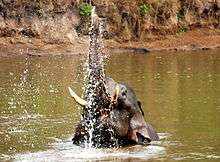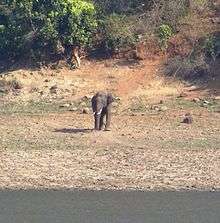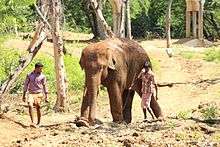Indian elephant
| Indian elephant | |
|---|---|
.jpg) | |
| Tusked male, Bandipur National Park | |
 | |
| Female, Nagarhole National Park | |
| Scientific classification | |
| Kingdom: | Animalia |
| Phylum: | Chordata |
| Class: | Mammalia |
| Order: | Proboscidea |
| Family: | Elephantidae |
| Genus: | Elephas |
| Species: | Elephas maximus |
| Subspecies: | E. m. indicus |
| Trinomial name | |
| Elephas maximus indicus (Cuvier), 1798 | |
The Indian elephant (Elephas maximus indicus) is one of three recognized subspecies of the Asian elephant and native to mainland Asia. Since 1986, Elephas maximus has been listed as Endangered by IUCN as the population has declined by at least 50% over the last 60 to 75 years or three generations. Asian elephants are threatened by habitat loss, degradation and fragmentation.[1]
Characteristics
In general, Asian elephants are smaller than African elephants and have the highest body point on the head. The tip of their trunk has one finger-like process. Their back is convex or level.[2] Indian elephants reach a shoulder height of between 2 and 3.5 m (6.6 and 11.5 ft), weigh between 2,000 and 5,000 kg (4,400 and 11,000 lb), and have 19 pairs of ribs. Their skin color is lighter than of maximus with smaller patches of depigmentation, but darker than of sumatranus. Females are usually smaller than males, and have short or no tusks.[3]
The largest Indian elephant was 3.43 metres (11.3 ft) high at the shoulder.[4] In 1985, two large elephant bulls were spotted for the first time in Bardia National Park, and named Raja Gaj and Kanchha. They roamed the park area together and made occasional visits to the females. Raja Gaj stood 11.3 ft (3.4 m) tall at the shoulder and had a massive body weight. His appearance has been compared to that of a mammoth due to his high bi-domed shaped head. His forehead and domes were more prominent than in other Asian bull elephants.[5][6]
Indian elephants have smaller ears, but relatively broader skulls and larger trunks than African elephants. Toes are large and broad. Unlike their African cousins, their abdomen is proportionate with their body weight but the African elephant has a large abdomen as compared to the skulls.
Distribution and habitat



Indian elephants are native to mainland Asia: India, Nepal, Bangladesh, Bhutan, Myanmar, Thailand, Malay Peninsular, Laos, China, Cambodia, and Vietnam. They are regionally extinct from Pakistan.[1] They inhabit grasslands, dry deciduous, moist deciduous, evergreen and semi-evergreen forests. In the early 1990s, their estimated population size was[7]
- 27,785–31,368 in India,[8] where populations are restricted to four general areas:
- in the Northwest — at the foot of the Himalayas in Uttarakhand and Uttar Pradesh, ranging from Katarniaghat Wildlife Sanctuary to the Yamuna River;
- in the Northeast – from the eastern border of Nepal in northern West Bengal through western Assam along the Himalaya foothills as far as the Mishmi Hills, extending into eastern Arunachal Pradesh, the plains of upper Assam, and the foothills of Nagaland, to the Garo Hills of Meghalaya through the Khasi Hills, to parts of the lower Brahmaputra plains and Karbi Plateau; isolated herds occur in Tripura, Mizoram, Manipur, and in the Barak Valley districts of Assam:
- in the central part — in Orissa, Jharkhand, and in the southern part of West Bengal, with some animals wandering into Chhattisgarh;
- in the South – eight populations are fragmented from each other in northern Karnataka, in the crestline of Karnataka–Western Ghats, in Bhadra–Malnad, in Brahmagiri–Nilgiris–Eastern Ghats, in Nilambur–Silent Valley–Coimbatore, in Anamalai–Parambikulam, in Periyar–Srivilliputhur, and one in Agasthyamalai;
- 100–125 in Nepal, where their range is restricted to a few protected areas in the Terai along the border with India. In 2002, estimates ranged from 106 to 172 resident and migratory elephants, with most of them in Bardia National Park;[9]
- 150–250 in Bangladesh, where only isolated populations survive in the Chittagong Hills;
- 250–500 in Bhutan, where their range is limited to protected areas in the south along the border with India;
- 4,000–5,000 in Myanmar, where populations are highly fragmented, and occur in the northern and western hill ranges, in Pegu Yoma of central Myanmar, Tenasserim and Shan State;
- 2,500–3,200 in Thailand, mainly in the mountains along the border with Myanmar, with smaller fragmented populations occurring in the peninsula in the south;
- 2,100–3,100 in Malaysia;
- 500–1,000 Laos, where they remain widely but patchily distributed in forested areas, both in the highlands and lowlands;
- 200–250 in China, where they survive only in the prefectures of Xishuangbanna, Simao, and Lincang of southern Yunnan;
- 250–600 in Cambodia, where they primarily inhabit the mountains of the south-west and in Mondulkiri and Ratanakiri Provinces;
- 70–150 in the southern parts of Vietnam.
Ecology and behaviour

Elephants are classified as megaherbivores and consume up to 150 kg (330 lb) of plant matter per day.[10] They are generalist feeders, and both grazers and browsers. In a study area of 1,130 km2 (440 sq mi) in southern India, elephants were recorded to feed on 112 different plant species, most commonly of the order Malvales, and the legume, palm, sedge and true grass families. They graze on the tall grasses, but the portion consumed varies with season. When the new flush appears in April, they remove the tender blades in small clumps. Later, when grasses are higher than 0.5 m (1.6 ft), they uproot entire clumps, dust them skilfully and consume the fresh leave tops, but discard the roots. When grasses are mature in autumn, they clean and consume the succulent basal portions with the roots, and discard the fibrous blades. From the bamboos, they eat seedlings, culms and lateral shoots. During the dry season from January to April, they mainly browse on both leaves and twigs preferring the fresh foliage, and consume thorn bearing shoots of acacia species without any obvious discomfort. They feed on the bark of white thorn and other flowering plants, and consume the fruits of wood apple, tamarind, kumbhi and date palm.[11]
In Nepal's Bardia National Park, elephants consume large amounts of the floodplain grass, particularly during the monsoon season. They browse more in the dry season with bark constituting a major part of their diet in the cool part of that season.[12] During a study in a tropical moist mixed deciduous forested area of 160 km2 (62 sq mi) in Assam, elephants were observed to feed on about 20 species of grasses, plants and trees. Grasses such as Imperata cylindrica and Leersia hexandra constituted by far the most predominant component of their diet.[13]
The movement and habitat utilisation patterns of an elephant population were studied in southern India during 1981–83 within a 1,130 km2 (440 sq mi) study area. The vegetation types of this area encompasses dry thorn forest at 250 to 400 m (820 to 1,310 ft), deciduous forest at 400 to 1,400 m (1,300 to 4,600 ft), stunted evergreen forest and grassland at 1,400 to 1,800 m (4,600 to 5,900 ft). Five different elephant clans, each consisting of between 50 and 200 individuals had home ranges of between 105 km2 (41 sq mi) and 320 km2 (120 sq mi), which overlapped. They preferred habitat where water was available and food plants were palatable. During the dry months of January to April, they congregated at high densities of up to five individuals per km2 in river valleys where browse plants had a much higher protein content than the coarse tall grasses on hill slopes. With the onset of rains in May, they dispersed over a wider area at lower densities, largely into the tall grass forests, to feed on the fresh grasses, which then had a high protein value. During the second wet season from September to December, when the tall grasses became fibrous, they moved into lower elevation short grass open forests. The normal movement pattern could be upset during years of adverse environmental conditions. However, the movement pattern of elephants in this region has not basically changed for over a century, as inferred from descriptions recorded during the 19th century.[14]
In the Nilgiri Biosphere Reserve three elephant clans had overall home ranges of 562 km2 (217 sq mi), 670 km2 (260 sq mi) and 799 km2 (308 sq mi) in the beginning of the 1990s. During three years of survey, their annual home ranges overlapped to a large extent with only minor shifts in the home ranges between years.[15]
Threats

.jpg)
The pre-eminent threats to Asian elephants today are habitat loss, degradation, and fragmentation, which are driven by an expanding human population, and lead in turn to increasing conflicts between humans and elephants when elephants eat or trample crops.[1] Loss of significant extents of elephant range and suitable habitat continues; their free movement is impeded by reservoirs, hydroelectric projects and associated canals, irrigation dams, numerous pockets of cultivation and plantations, highways, railway lines, mining and industrial development.[7] Elephant calves are vulnerable to predation.[16]
Poaching of elephants for ivory is a serious threat in some parts of Asia. Poaching of tuskers impacts on sex ratios that become highly female biased; genetic variation is reduced, and fecundity and recruitment may decline.[7] Poaching has dramatically skewed adult sex ratios in the Periyar Tiger Reserve, where between 1969 and 1989 the adult male:female sex ratio changed from 1:6 to 1:122.[17]
Elephant conservation in northern West Bengal has been set back due to high-levels of human–elephant conflict and elephant mortality owing to railway accidents. The railway track between Siliguri and Alipurduar passes through 74 km (46 mi) of various forest divisions. Every day, 20 trains run on this track at high speeds. Elephants that pass through from one forest patch to another dash against the trains and die. A total of 39 dead elephants were reported during the period of 1958 to 2008, of which ten were reported killed between 2004 and 2008.[18]
In Bangladesh, forested areas that served as prime elephant habitat have undergone drastic reduction, which had a severe impact on the wild elephant population. Habitat loss and fragmentation is attributed to the increasing human population and its need for fuel wood and timber. Illegal timber extraction plays a significant role in deforestation and habitat degradation. As a result of the shrinking habitat, elephants have become more and more prone to coming into direct conflict with humans.[19]
In Myanmar, demand for elephant ivory for making tourist items is higher than ever before. The military government shows little interest in reducing the ivory trade, while the elephants in the country have become the silent victims. After the world-wide ivory ban, prices of raw ivory in the country skyrocketed from $76 a kilo for large tusks in 1989/90 to over $200 a kilo by the mid-1990s. Foreign tourists are responsible for the massive rise in price of ivory tusks which fuels the illegal killing of elephants. There is also a sizeable trade in ivory chopsticks and carvings, smuggled by traders from Myanmar into China.[20]
Young wild-born elephants are removed from their mothers in Myanmar for use in Thailand's tourism industry. Mothers are often killed in the process, and calves are placed alongside unrelated cows to suggest they are with their mothers.[21] The calves are often subjected to a 'breaking in' process, which may involve being tied up, confined, starved, beaten and tortured, as a result of which two-thirds may perish.[22]
Conservation

Elephas maximus is listed on CITES Appendix I.[1] Project Elephant was launched in 1992 by the Government of India Ministry of Environment and Forests to provide financial and technical support of wildlife management efforts by states for their free ranging populations of wild Asian Elephants. The project aims to ensure long-term survival of viable conservation reliant populations of elephants in their natural habitats by protecting the elephants, their habitats and migration corridors. Other goals of Project Elephant are supporting research of the ecology and management of elephants, creating conservation awareness among local people, providing improved veterinary care for captive elephants.[23][24]
See also
References
- 1 2 3 4 Choudhury, A.; Lahiri Choudhury, D. K.; Desai, A.; Duckworth, J. W.; Easa, P. S.; Johnsingh, A. J. T.; Fernando, P.; Hedges, S.; Gunawardena, M.; Kurt, F.; et al. (2008). "Elephas maximus". IUCN Red List of Threatened Species. Version 2012.2. International Union for Conservation of Nature.
- ↑ Shoshani, J., Eisenberg, J. F. (1982). Elephas maximus. Mammalian Species 182: 1–8.
- ↑ Shoshani, J. (2006). Taxonomy, Classification, and Evolution of Elephants In: Fowler, M. E., Mikota, S. K. (eds.) Biology, medicine, and surgery of elephants. Wiley-Blackwell. ISBN 0-8138-0676-3. pp. 3–14.
- ↑ Pillai, N.G. (1941). On the height and age of an elephant. Journal of the Bombay Natural History Society 42: 927–928.
- ↑ Furaha tenVelde, P. (1997). The wild elephants of the Royal Bardia National Park, Nepal. Gajah: Journal of the IUCN/SSC Asian Elephant Specialist Group 17: 41–44.
- ↑ Ben S. Roesch. "Living Stegodont or Genetic Freak?". Archived from the original on 8 November 2006. Retrieved 2008-06-18.
- 1 2 3 Sukumar, R. (1993). The Asian Elephant: Ecology and Management Second edition. Cambridge University Press. ISBN 0-521-43758-X
- ↑ "Elephant population in India". Government of India. Retrieved 31 January 2016.
- ↑ Bhatta, S. R. (2006) Efforts to conserve the Asian elephant in Nepal. Gajah: Journal of the IUCN/SSC Asian Elephant Specialist Group 25: 87–89.
- ↑ Samansiri, K. A. P., Weerakoon, D. K. (2007). Feeding Behaviour of Asian Elephants in the Northwestern Region of Sri Lanka. Gajah: Journal of the IUCN/SSC Asian Elephant Specialist Group. Number 2: 27–34
- ↑ Sukumar, R. (1990). Ecology of the Asian Elephant in southern India. II. Feeding habits and crop raiding patterns Archived 12 October 2007 at the Wayback Machine.. Journal of Tropical Ecology (1990) 6: 33–53.
- ↑ Pradhan, N.M.B., Wegge, P., Moe, S.R., Shrestha, A.K. (2008). Feeding ecology of two endangered sympatric megaherbivores: Asian elephant Elephas maximus and greater one-horned rhinoceros Rhinoceros unicornis in lowland Nepal. Wildlife Biology 14: 147–154.
- ↑ Borah, J., Deka, K. (2008). Nutritional Evaluation of Forage Preferred by Wild Elephants in the Rani Range Forest, Assam, India. Gajah: Journal of the IUCN/SSC Asian Elephant Specialist Group 28: 41–43.
- ↑ Sukumar, R. (1989). Ecology of the Asian elephant in southern India. l. Movement and habitat utilization patterns. Journal of Tropical Ecology 5: 1–18.
- ↑ Baskaran, N., Desai, A. A. (1996). Ranging behaviour of the Asian elephant (Elephas maximus) in the Nilgiri Biosphere Reserve, South India. Gajah: Journal of the IUCN/SSC Asian Elephant Specialist Group 15: 41–57.
- ↑ Joshi, R. (2009), "Asian Elephant's Elephas maximus Behaviour in the Rajaji National Park, North-West India: Eight Years with Asian Elephant" (PDF), Nature and Science, 7 (1): 49–77
- ↑ Chandran, P. M. (1990). Population dynamics of elephants in Periyar Tiger Reserve. Pages 51–56 in: C. K. Karunakaran (ed.) Proceedings of the Symposium on Ecology, Behaviour and Management of Elephants in Kerala. Kerala Forest Department, Trivandrum, India.
- ↑ Roy, M. Baskaran, N., Sukumar, R. (2009). The Death of Jumbos on Railway Tracks in Northern West Bengal. Gajah: Journal of the IUCN/SSC Asian Elephant Specialist Group 31: 36–39.
- ↑ Islam, M.–A. (2006). Conservation of the Asian elephant in Bangladesh. Gajah: Journal of the IUCN/SSC Asian Elephant Specialist Group 25: 21–26.
- ↑ Vigne, L., Martin, E. (2002). Myanmar’s ivory trade threatens wild elephants. Gajah: Journal of the IUCN/SSC Asian Elephant Specialist Group 21: 85–86.
- ↑ Shand, M. (21 July 2012). "The agonising blows that expose the evil secrets of Thailand's elephant tourism con: The Duchess of Cornwall's brother tells how baby elephants are brutally starved and tortured". Daily Mail. London. Retrieved 22 July 2012.
- ↑ "Tourism driving illegal elephant trade in Burma and Thailand – video". guardian.co.uk. London. 24 July 2012.
- ↑ "Project Elephant". wildlifeofindia.org. Retrieved 30 January 2016.
- ↑ "Project Elephant". Government of India. Retrieved 30 January 2016.
Further reading
- G. P. Sanderson (1907) Thirteen years among the wild beasts of India: their haunts and habits from personal observation : with an account of the modes of capturing and taming elephants. John Grant, Edinburgh. 8th edition in 2000 by Asian Educational Services, New Delhi. ISBN 81-206-1464-X. ISBN 978-81-206-1464-2
External links
| Wikimedia Commons has media related to Elephas maximus indicus. |
- WWF: Indian elephant
- Animal Diversity Web: Elephas maximus Asiatic elephant
- Honolulu Zoo: Indian Elephant
- Paintings of Indian Elephants